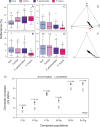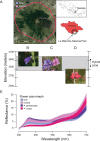Pollinator divergence and pollination isolation between hybrids with different floral color and morphology in two sympatric Penstemon species
- PMID: 32415216
- PMCID: PMC7229217
- DOI: 10.1038/s41598-020-64964-8
Pollinator divergence and pollination isolation between hybrids with different floral color and morphology in two sympatric Penstemon species
Abstract
Differential visitation of pollinators due to divergent floral traits can lead to reproductive isolation via assortative pollen flow, which may ultimately be a driving force in plant speciation, particularly in areas of overlap. We evaluate the effects of pollinator behavioral responses to variation of intraspecific floral color and nectar rewards, on reproductive isolation between two hybrid flower color morphs (fuchsia and blue) and their parental species Penstemon roseus and P. gentianoides with a mixed-pollination system. We show that pollinators (bumblebees and hummingbirds) exhibit different behavioral responses to fuchsia and blue morphs, which could result from differential attraction or deterrence. In addition to differences in color (spectral reflectance), we found that plants with fuchsia flowers produced more and larger flowers, produced more nectar and were more visited by pollinators than those with blue flowers. These differences influenced the foraging behavior and effectiveness as pollinators of both bumblebees and hummingbirds, which contributed to reproductive isolation between the two hybrid flower color morphs and parental species. This study demonstrates how differentiation of pollination traits promotes the formation of hybrid zones leading to pollinator shifts and reproductive isolation. While phenotypic traits of fuchsia and red flowers might encourage more efficient hummingbird pollination in a mixed-pollination system, the costs of bumblebee pollination on plant reproduction could be the drivers for the repeated shifts from bumblebee- to hummingbird-mediated pollination.
Conflict of interest statement
The authors declare no competing interests.
Figures





References
-
- Thomson JD, Wilson P. Explaining evolutionary shifts between bee and hummingbird pollination: convergence, divergence, and directionality. Int J Pl Sci. 2008;169:23–38. doi: 10.1086/523361. - DOI
Publication types
MeSH terms
LinkOut - more resources
Full Text Sources

